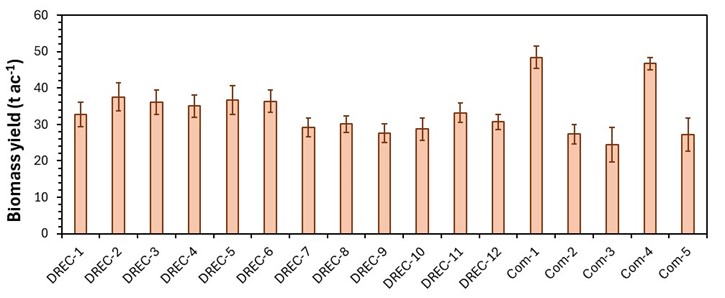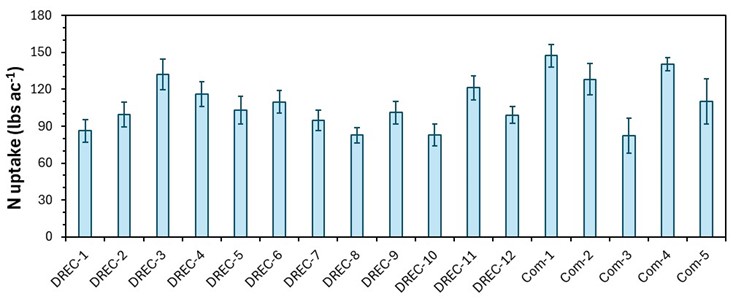Note: This is part of a Research Update series that highlights projects funded by the California Department of Food and Agriculture (CDFA) Fertilizer Research and Education Program (FREP).
Project Title: Developing Tools and Information on Irrigation and Nitrogen Best Management Practices in California’s Low Desert Lettuce Production Systems
Project Lead: Ali Montazar, Irrigation and Water Management Advisor, University of California Cooperative Extension (UCCE), Desert Research and Extension Center (DREC)
Project Status: Year 2 (3-year project)
Project location: Imperial and Coachella Valleys
Overview: This FREP-funded project develops knowledge and information on improving and promoting adoption of management practices that optimize nitrogen (N) and irrigation water use efficiency in California’s low desert lettuce production systems. This blog post presents a portion of the data collected during the first two years of this three-year project.
Background
Recent water quality regulations and increases in fertilizer prices have spurred growers’ interest in improving N use efficiency. The intensive production of lettuce in the low desert region demands substantial inputs of fertilizer and irrigation water resulting in a significant impact on water quality and the potential for nitrate leaching into groundwater. Lettuce growers could reduce N fertilizer use and address water quality concerns by enhancing water management and aligning N applications with the crop’s N uptake pattern. Studies on lettuce response to N fertilization have shown considerable variability. A survey of lettuce fields revealed an average seasonal N application rate of 164 lbs./ac, indicating that a substantial reduction in N rates would be necessary to comply with new regulations. Additionally, it is well-documented that plants under salt stress may reduce water uptake and alter nutrient absorption ratios.
A variety of irrigation and nitrogen management practices are used to produce lettuce in the low desert region. The dominant irrigation system is furrow irrigation, although some growers use drip irrigation in iceberg and romaine lettuces, and sprinkler irrigation is typically used in leaf lettuce. In addition, growers commonly manage salinity issues by applying excessive water to leach salts during the summer. However, most prior studies have been conducted under conditions that differ from those found in California’s low desert lettuce production systems (e.g., climate, irrigation and fertilization practices, salinity, and cropping systems). Thus, there is an urgent need for updated N uptake data that accurately reflects the conditions of this region.
Approach
Ongoing field trials are being conducted over a three-year period in the Imperial and Coachella Valleys. (Figure 1) In the Imperial Valley, iceberg lettuce trials are taking place at UC DREC under two drip irrigation system configurations (with two irrigation regimes and three N application scenarios) and two summer salt leaching strategies. Additionally, the experiment is being conducted across 12 commercial fields, including five iceberg lettuce fields (three with drip irrigation and two with furrow irrigation), four romaine lettuce fields (two with drip irrigation and two with sprinkler irrigation), and three leaf lettuce fields irrigated by sprinkler systems. Three N fertilizer strategies are evaluating 1) the standard N application commonly used by regional growers, 2) 130% of the N recommended by CropManage (irrigation and N application decision support tool) and 3) 100% of the CropManage N recommendation. These strategies are tested under two irrigation regimes (100% of crop evapotranspiration (ET) and 150% of crop ET). In addition, summer leaching, based on common grower practices, will be implemented in all plots. In the drip-irrigated commercial fields, the study will investigate three N application rates in replicated trials: one grower rate and two lower rates, each less than the grower’s typical application rate. Researchers are collecting a range of data and measurements, including soil tests for nitrate, salinity, phosphorus, and potassium (both plant and soil), canopy reflectance, and crop biomass.

Figure 1. A demonstration of romaine lettuce trial field in the Coachella Valley (a) and Imperial Valley (b), iceberg lettuce 80” bed spacings trial at DREC in the Imperial Valley (c) and iceberg 40” bed spacings at DREC in the Imperial Valley (d). The water applied was measured using a magnetic flowmeter attached to a datalogger and analyzed by CropManage.
Findings
This is a three-year project, and the results presented in this blog post offer a snapshot of the second-year data, including lettuce biomass yield and N uptake across the trials.
Results showed a considerable difference in plant density, ranging from 27,181 plants per acre in the 40”-bed spacings trials to an average of 49,446 plants per acre in the 80”-bed spacings trials. Variable water and N application rates were observed at the experimental sites. The N unit applications varied from 90 to 160 lbs./ac at the DREC trials and other commercial fields with heavy soil texture. In contrast, this range was 260 to 285 lbs./ac in sandy soils.
Greater biomass yield (averaging 34%) was observed at the 80-in bed lettuce trials in comparison with the 40-in bed lettuce trials. While a significant impact of N application rate on biomass yield wasn’t found, a wide range of biomass yield was observed across the trials, ranging from 24.5 ton/ac to 48.4 ton/ac (Figure 2.)

Figure 2. Biomass yields in different trials. Standard deviation of the corresponding biomass yields is shown on the bars.
A wide range of N uptake values at harvest were determined across the experimental sites and treatments (Figure 3). Mean values varied from 82.1 lbs./acre in a head lettuce field with 40-in beds to 147.3 lbs./ac in another head lettuce field with 80-in beds. The results demonstrated more variations in the N uptake values than the biomass yields among the trials. For instance, there was not a considerable biomass difference between trials (e.g. 27.4 ton/ac vs. 24.5 ton/ac); however, a significant difference was found between N uptake at these trials (128.1 lbs./ac vs. 82.4 lbs./ac, respectively).

Figure 3. N uptake values in different trials. Standard deviation of the corresponding N uptake values is shown on the bars.
Conclusions
A wide range of N uptake values were obtained in desert head and romaine lettuces across the trials reported, varying from less than 80 lbs./ac to greater than 150 lbs/ac. A more comprehensive statistical analysis will be conducted on the impacts of N and irrigation applications on drip irrigated desert lettuces in the upcoming year. The findings of this study suggested that lettuce growth could be maximized by seasonal N fertilization and irrigation water application rates below current typical practices even in drip irrigated fields. CropManage (https://cropmanage.ucanr.edu/), as a free decision-making tool, may assist local growers to maximize lettuce production and improve the efficiency of N and water use.
This blog post presents a summary of this project and some of its findings and does not include all the data collected in this study. To receive the complete report for this project contact FREP at FREP@cdfa.ca.gov
To learn more about other current and completed FREP projects please visit the FREP Research & Project Database.


